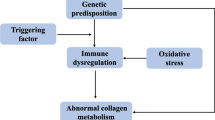Abstract
Lichen sclerosus et atrophicus is a chronic inflammatory disorder that mainly affects girls of premenarchial age and women in their fifties. Besides the anogenital region, lichen sclerosus (LS) may also affect extragenital or mucosal areas. Symptoms include soreness and pruritus, but other less common symptoms are not rare. An increased activity of fibroblasts causes increased sclerosis of the affected skin. Latest studies have identified LS as a chronic inflammatory dermatosis. Auto-antibodies against the extracellular membrane protein-1 are present in up to 80% of the patients. Moreover, in the widely accepted therapy with potent corticosteroids promising results have been presented using calcineurin antagonists in the treatment of LS. An interdisciplinary management and a continued care of patients with LS will improve the clinical manifestations and quality of life.







Similar content being viewed by others
References
Ridley CM, Frankman O, Jones IS et al (1989) New nomenclature for vulvar disease: International society for the study of vulvar disease. Hum Pathol 20:495–496
Powell J, Wojnarowska F (2002) Childhood vulvar lichen sclerosus. The course after puberty. J Reprod Med 47:706–709
Kizer WS, Prarie T, Morey AF (2003) Balanitis xerotica obliterans: epidemiologic distribution in an equal access health care system. South Med J 96:9–11
Powell J, Wojnarowska F (2001) Childhood vulvar lichen sclerosus: an increasingly common problem. J Am Acad Dermatol 44:803–806
Meyrick Thomas RH, Ridley CM et al (1988) Lichen sclerosus et atrophicus and autoimmunity—a study of 350 women. Br J Dermatol 118:41–46
Assmann T, Becker-Wegerich P, Grewe M et al (2003) Tacrolimus ointment for the treatment of vulvar lichen sclerosus. J Am Acad Dermatol 48:935–937
Scrimin F, Rustja S, Radillo O et al (2000) Vulvar lichen sclerosus: an immunologic study. Obstet Gynecol 95:147–150
Oyama N, Chan I, Neill SM et al (2003) Autoantibodies to extracellular matrix protein 1 in lichen sclerosus. Lancet 362:118–123
Jensen T, Worsaae N, Melgaard B (2002) Oral lichen sclerosus et atrophicus: a case report. Oral Surg Oral Med Oral Pathol Oral Radiol Endod 94:702–706
Powell JJ, Wojnarowska F (1999) Lichen sclerosus. Lancet 353:1777–1783
Carlson JA, Grabowski R, Chichetser P et al (2000) Comparative immunophenmotypic stuidy of lichen sclerosus: epidermotropic CD57+ lymphocytes are numerous—implications für pathogenesis. Am J Dermatopathol 22:7–16
Oyama N, Chan I, Neill SM et al (2004) Development of antigen-specific ELISA for circulating autoantibodies to extracellular matrix protein 1 in lichen sclerosus. J Clin Invest 113:1550–1559
Neill SM, Ridley CM (2001) Management of anogenital lichen sclerosus. Clin Exp Dermatol 26:637–643
Cooper SM, Gao XH, Powell JJ et al (2004) Does treatment of vulvar lichen sclerosus influence its prognosis? Arch Dermatol 140:702–706
Dahlman-Ghozlan K, Hedblad MA, von Krogh G (1999) Penile lichen sclerosus et atrophicus treated with clobetasol dipropionate 0.05% cream: a retrospective clinical and histopathological study. J Am Acad Dermatol 40:451–457
Dalziel KL, Millard PR, Wojnarowska F (1991) The treatment of vulval lichen sclerosus with a very potent topical steroid (clobetasol propionate 0.05%) cream. Br J Dermatol 124:461–464
Lorenz B, Kaufman RH, Kutzner SK (1998) Lichen sclerosus. Therapy with clobetasol propionate. J Reprod Med 43:790–794
Hillemanns P, Untch M, Prove F et al (1999) Photodynamic therapy of vulvar lichen sclerosus with 5-aminolevulinic acid. Obstet Gynecol 93:71–74
Reichrath J, Reinhold U, Tilgen W (2002) Treatment of genito-anal lesions in inflammatory skin diseases with PUVA cream photochemotherapy: an open pilot study in 12 patients. Dermatology 205:245–248
Alomar A, Berth-Jones J, Bos JD et al (2004) The role of topical calcineurin inhibitors in atopic dermatitis. Br J Dermatol 151(Suppl 70):3–27
Ruzicka T, Bieber T, Schopf E et al (1997) A short-term trial of Tacrolimus ointment for atopic dermatitis. European tacrolimus multicenter atopic dermatitis study group. N Engl J Med 337:816–821
Meykadeh N, Hengge UR (2003) Topische Immunmodulation in der Dermatologie. Hautarzt 54:641–662
Stander S, Luger TA (2003) Antipruritic effects of pimecrolimus and Tacrolimus. Hautarzt 54:413–417
Bohm M, Frieling U, Luger TA, Bonsmann G (2003) Successful treatment of anogenital lichen sclerosus with topical tacrolimus. Arch Dermatol 139:922–924
Kunstfeld R, Kirnbauer R, Stingl G, Karlhofer FM (2003) Successful treatment of vulvar lichen sclerosus with topical tacrolimus. Arch Dermatol 139:850–852
Goldstein AT, Marinoff SC, Christopher K (2004) Pimecrolimus for the treatment of vulvar lichen sclerosus in a premenarchal girl. J Pediatr Adolesc Gynecol 17:35–37
Goldstein AT, Marinoff SC, Christopher K (2004) Pimecrolimus for the treatment of vulvar lichen sclerosus: a report of 4 cases. J Reprod Med 49:778–780
Hagedorn M, Buxmeyer B, Schmitt Y, Bauknecht T (2002) Survey of genital lichen sclerosus in women and men. Arch Gynecol Obstet 266:86–91
Kanwar AJ, Thami GP, Kaur S et al (2002) Squamous cell carcinoma in long-standing untreated lichen sclerosus et atrophicus of the penis. Urol Int 68:291–294
Carli P, Cattaneo A, De Magnis A et al (1995) Squamous cell carcinoma arising in vulval lichen sclerosus: a longitudinal cohort study. Eur J Cancer Prev 4:491–495
Hengge UR, Ruzicka T, Cork M et al (2005) Adverse effects of topical glucocorticosteroids. J Am Acad Dermatol (in press)
von Krogh G, Dahlman-Ghozlan K, Syrjanen S (2002) Potential human papillomavirus reactivation following topical corticosteroid therapy of genital lichen sclerosus and erosive lichen planus. J Eur Acad Dermatol Venereol 16:130–133
Author information
Authors and Affiliations
Corresponding author
Rights and permissions
About this article
Cite this article
Strittmatter, H.J., Hengge, U.R. & Blecken, S.R. Calcineurin antagonists in vulvar lichen sclerosus. Arch Gynecol Obstet 274, 266–270 (2006). https://doi.org/10.1007/s00404-006-0151-1
Received:
Accepted:
Published:
Issue Date:
DOI: https://doi.org/10.1007/s00404-006-0151-1




